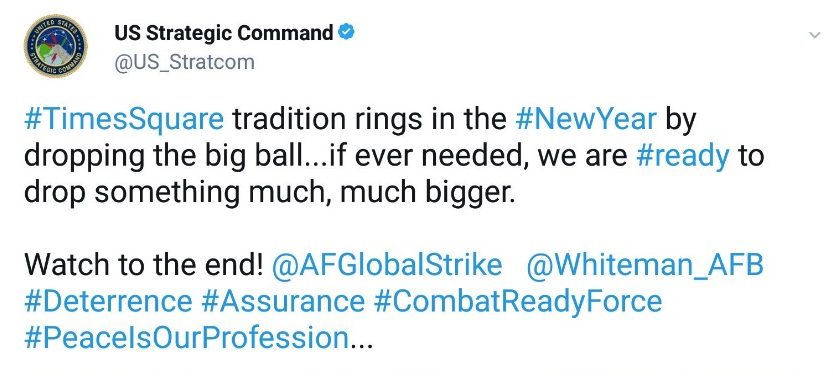Screengrab: Whiteman Spirit Video, by SrA Thomas Barley.
We’ve all made bad tweets, but the consequences for those tweets don’t usually threaten life on the planet.Tweeting out a thinly-veiled threat to drop a nuclear bomb isn’t a typical gaffe, but that’s what US Strategic Command (Stratcom)—a joint military command responsible for strategic deterrence, missile defense, and nuclear operations—did via its official Twitter account on New Year’s Eve. Stratcom deleted the tweet a few hours later, but not before I saved it.It’s posted below: A slickly-produced video embedded in the tweet showed a B-2 Bomber—a stealth jet capable of dropping a nuke—dropping bombs overlaid with the word “LETHAL.” Some followers were horrified by the agency in charge of of the nuclear triad—America’s intercontinental ballistic missiles, strategic bombers, and submarine-launched ballistic missiles—tweeting veiled threats on New Year’s Eve, and Stratcom pulled the tweet and issued an apology.Despite the directive to have a “professional” tone on Twitter, the nuclear agency sometimes makes off-color remarks. In April, 2018, it tweeted a cartoon implying that its B-2 bombers are more deadly than masked killer Jason Voorhees from Friday the 13th. The cartoon is clearly a joke that is arguably in poor taste. To most civilians, this may seem like small stuff, but Stratcom is in charge of nuclear deterrence. It’s a serious military operation with of the most important jobs on the planet and foreign governments, many of them unfriendly, are always watching.
A slickly-produced video embedded in the tweet showed a B-2 Bomber—a stealth jet capable of dropping a nuke—dropping bombs overlaid with the word “LETHAL.” Some followers were horrified by the agency in charge of of the nuclear triad—America’s intercontinental ballistic missiles, strategic bombers, and submarine-launched ballistic missiles—tweeting veiled threats on New Year’s Eve, and Stratcom pulled the tweet and issued an apology.Despite the directive to have a “professional” tone on Twitter, the nuclear agency sometimes makes off-color remarks. In April, 2018, it tweeted a cartoon implying that its B-2 bombers are more deadly than masked killer Jason Voorhees from Friday the 13th. The cartoon is clearly a joke that is arguably in poor taste. To most civilians, this may seem like small stuff, but Stratcom is in charge of nuclear deterrence. It’s a serious military operation with of the most important jobs on the planet and foreign governments, many of them unfriendly, are always watching.
Advertisement
“This post, which has since been deleted, was part of our Year in Review series meant to feature our command priorities: strategic deterrence, decisive response and combat-ready force,” a Stratcom spokesperson told The Washington Post. The spokesperson explained that the video was a repost from earlier in the year showing off a conventional pair of Massive Ordnance Penetrators at a US test range.Mistakes happen, but the tweet begs the question, why is US Strategic Command tweeting in the first place and what’s the point of such organizations running social media accounts?Social media is a powerful modern tool for communication and a weapon of war on the battlefield. Activists use it to organize, and governments use it spread both information and propaganda. Most government agencies, including US military groups, maintain some form of social media presence.According to Stratcom’s 2018 Communication Strategy handbook, social media is “a [public affairs] function that helps fulfill the command’s obligation to publicly communicate with global audiences.”
Advertisement
Martin Pfeiffer, a PhD candidate at the University of New Mexico and an expert in the anthropology of nuclear war, obtained a copy of Stratcom’s Communication Strategy handbook via a Freedom of Information Act request.“I accept that Stratcom will use [social media] and other channels to advocate for certain interests and to engage in activities designed to shape public opinion about nuclear weapons…and call it 'public education,’” Pfeiffer told me in a Twitter direct message. “I would prefer—in an ideal world—a much more restricted set of activities focused on transparency, discussing Stratcom activities, etc.”According to the handbook, Stratcom sees social media as an important part of its communication strategy. “Communication with the American public and international audiences builds public trust and understanding of the command’s contribution to national security,” the handbook explained. “And contributes to deterring adversary action, assures allies, helps shape the operation and informational environment, and helps define the future of the force.”According to the handbook, Stratcom’s Twitter audience “consists of media, academics, detractors, and the general public. The focus of effort will be on breaking events, amplifying key points from USSTRATCOM leadership speeches, engagements, and continuing discussions on 21st century strategic deterrence. Twitter Live stream when applicable and appropriate. General tone for posting to the page will be professional and no-nonsense.”"The US should present itself as a responsible possessor of our nuclear capabilities”
Advertisement
Jokes and provocations aside, Stratcom has amplified factual errors before. In November of, 2017, Stratcom shared an article that included the false detail that B-1 bombers are capable of deploying nuclear weapons. Pfeiffer said that inaccurate information may change how a foreign country views US capabilities.According to Pfeiffer, poorly timed Tweets could be used as justification for escalating tensions in a time of crisis. It may seem ridiculous now, but experts who study North Korea’s nuclear capabilities think that a few bad tweets could lead to a nuclear standoff or even war.“The US should present itself as a responsible possessor of our nuclear capabilities,” Pfeiffer said. “Comparing ourselves to Jason from Friday the 13th is counterproductive.”Nukes are serious business, Pfeiffer said, and nobody is left better off when military agencies make light of that responsibility. “Rather than educating the public on the horrifying and awesome potential of US military capabilities, including nuclear,” Pfeiffer said, “it approaches #NukePorn where we symbolically jerk off about how we can end life as we know it on the planet on a whim.”Get six of our favorite Motherboard stories every day by signing up for our newsletter.
